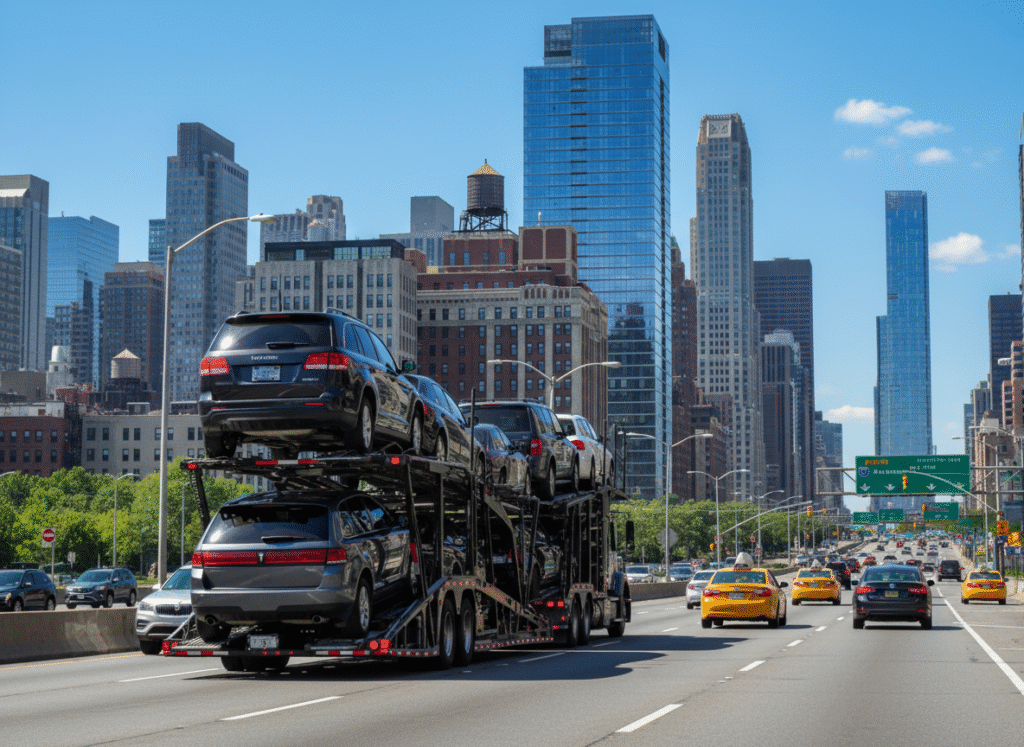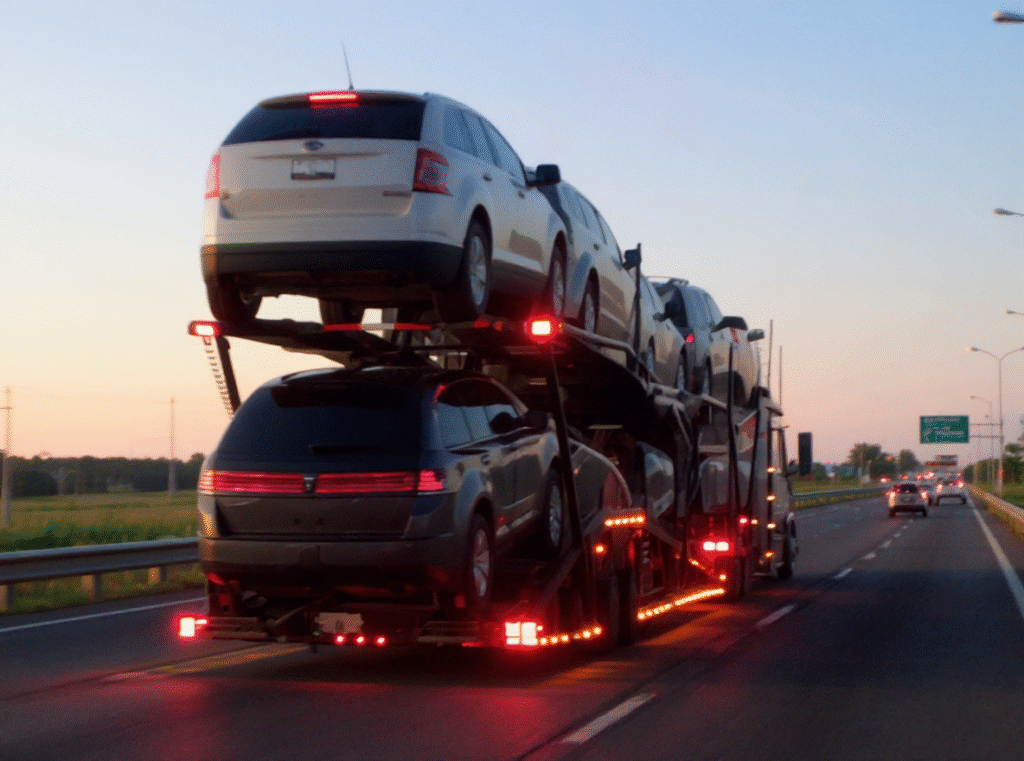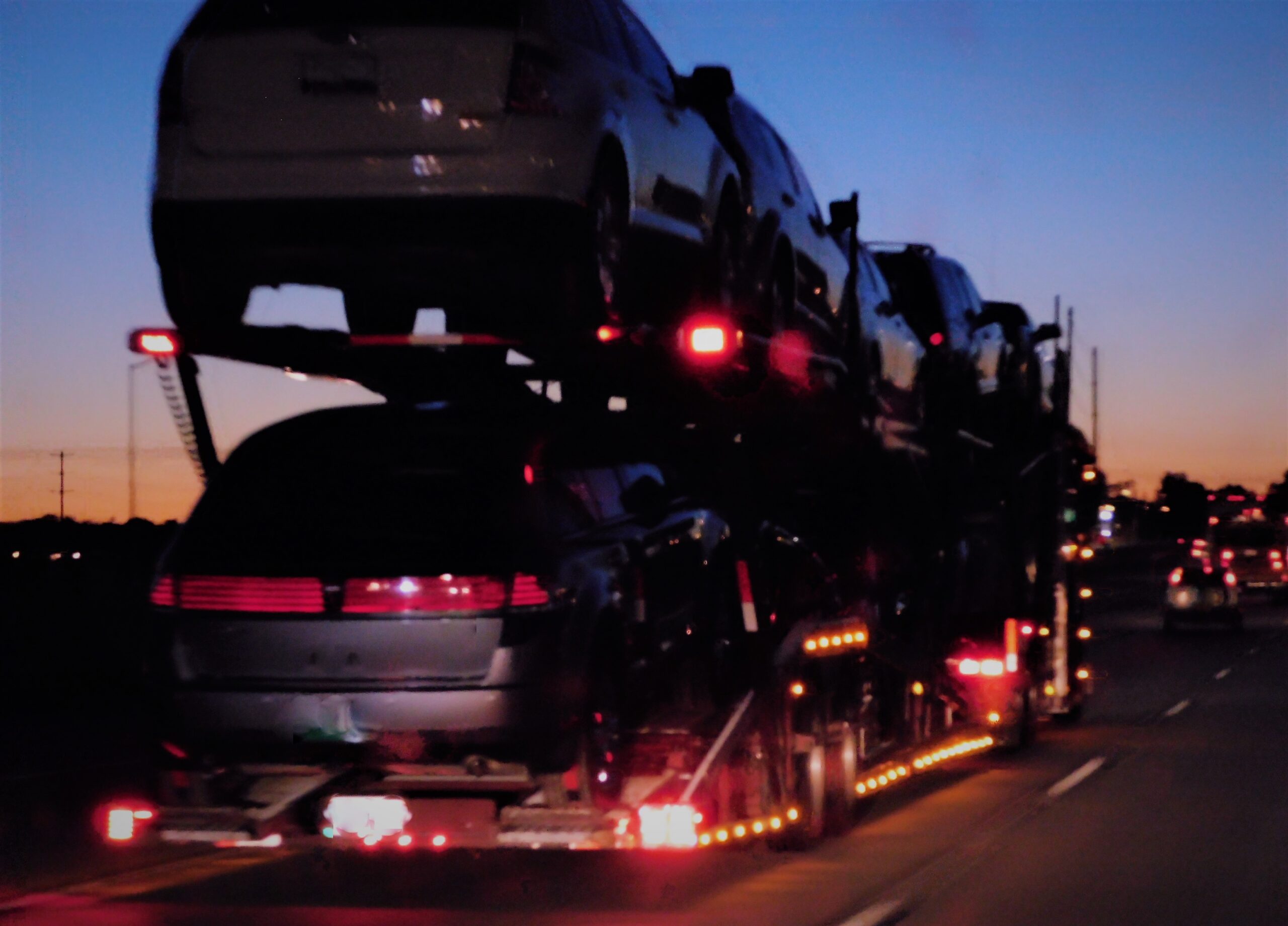Moving to New York or shipping a vehicle into the Empire State? Whether you’re relocating from California, sending a car to a college student in Manhattan, or bringing your second vehicle to a seasonal home in the Adirondacks, understanding the car shipping process saves time, money, and stress. New York’s dense urban centers, strict regulations, and diverse geography make choosing the right auto transport service crucial.
This guide walks you through everything you need to know to ship a car to New York confidently. You’ll learn what affects your quote, how to choose between transport methods, what timelines to expect, and how to prepare your vehicle for a smooth pickup and delivery.
Let’s break down the process so you can make an informed decision and get your car to New York safely.
Table of Contents
- Overview: Shipping a Car to New York
- Why Choose SpeedyWay Auto Transport
- Cost to Ship a Car to New York: What You’ll Pay
- Pickup Windows, Transit Time & Delivery Expectations
- Open vs Enclosed Transport: Which Is Right for You?
- Step-by-Step: How the Car Shipping Process Works
- Insurance Coverage & How to Prepare Your Vehicle
- How to Choose a Reliable Car Transport Service
- Common Mistakes & How to Avoid Them
- Special Situations: Students, Snowbirds, Auctions & More
- Frequently Asked Questions About New York car shipping
Overview: Shipping a Car to New York
New York is one of the busiest auto transport destinations in the United States. Whether you’re shipping to New York City, Buffalo, Albany, or Long Island, car shipping companies service the state year-round with frequent routes from every major U.S. city.
Why people ship cars to New York:
- Relocation: Job transfers, retirement, or lifestyle changes bring thousands of vehicles into New York annually.
- Seasonal residents: Snowbirds returning from Florida or Arizona for the summer months.
- College students: Parents sending vehicles to campuses across the state.
- Online purchases: Buyers acquiring vehicles from auctions or private sellers nationwide.
- Military and government: Personnel relocating to bases or assignments in the region.
New York’s infrastructure supports auto transport well, but urban delivery in NYC boroughs can require flexibility. Manhattan’s narrow streets and parking restrictions often mean meeting your carrier at a nearby accessible location rather than door-to-door delivery to your exact address.
Understanding these nuances helps you set realistic expectations and choose the right car transport service New York for your needs.

Why Choose SpeedyWay Auto Transport
When you need to ship your car to New York, working with an experienced, licensed carrier makes all the difference. SpeedyWay Auto Transport specializes in reliable, transparent auto transport with a focus on customer communication and on-time delivery.
What sets SpeedyWay apart:
- Nationwide coverage: Whether you ship car from CA to NY or from Florida to Buffalo, SpeedyWay operates on all major routes into New York.
- Transparent pricing: Quotes reflect real-world factors—no surprise fees at pickup.
- Flexible transport options: Choose open car transport for cost-effective shipping or enclosed car transport for premium protection.
- Licensed and insured: Full carrier insurance protects your vehicle throughout transit.
- Responsive support: Real people answer your questions from quote to delivery.
Customers appreciate SpeedyWay’s straightforward process and reliable updates. Reviews consistently highlight on-time pickups, careful handling, and clear communication—exactly what you need when entrusting your vehicle to a long-distance carrier.
Cost to Ship a Car to New York: What You’ll Pay
Understanding pricing helps you budget accurately and compare quotes from different car shipping companies New York. Auto transport costs vary based on several factors, but typical ranges give you a baseline.
Typical Price Ranges
- Ship car from CA to NY: $900–$1,400 (depending on exact cities, season, and transport type)
- Ship car from LA to NY: $950–$1,450
- Ship car from Florida to NY: $600–$1,000
- Ship car from Texas to NY: $700–$1,100
- Ship car from Chicago to NY: $500–$850
These estimates apply to standard sedans using open transport. Larger vehicles, enclosed transport, or expedited service increase costs.
Key Cost Factors
- Distance: Longer routes cost more, but per-mile rates decrease on cross-country shipments. Shipping from Los Angeles to New York costs less per mile than a 300-mile regional move.
- Transport type: Open car transport is the most affordable option, typically 30–40% less expensive than enclosed. Enclosed transport protects high-value, classic, or luxury vehicles from weather and road debris.
- Vehicle size and weight: SUVs, trucks, and oversized vehicles take up more carrier space and weigh more, increasing fuel costs. Expect 10–20% higher quotes for larger vehicles.
- Season and demand: Summer and early fall see peak demand as families relocate and students move to campus. Winter routes into New York may offer lower prices but can face weather delays. Snowbird season (October–November southbound, March–April northbound) tightens availability.
- Pickup and delivery locations: Urban areas with easy truck access cost less than remote rural locations. NYC deliveries sometimes incur small metro fees due to parking and navigation challenges.
- Vehicle condition: Inoperable vehicles require special loading equipment (winches), adding $100–$200 to the quote.
- Expedited service: Guaranteed pickup within 1–3 days costs more than standard 1–7 day windows.
For strategies to reduce costs without sacrificing service quality, see [The Cheapest Way To Ship A Car To Another State: Save On Auto Transport Costs]
Getting Accurate Quotes
When you request quotes from auto transport companies New York, provide accurate details:
- Exact pickup and delivery ZIP codes
- Vehicle year, make, and model
- Any modifications (lifted suspensions, oversized tires)
- Whether the vehicle runs and drives
- Preferred transport type (open or enclosed)
- Desired pickup window
Reputable carriers like SpeedyWay provide binding quotes—the price you’re quoted is the price you pay, barring changes you make to the shipment details.

Pickup Windows, Transit Time & Delivery Expectations
Timing matters when you ship car to New York. Understanding realistic windows helps you plan your schedule and avoid frustration.
Pickup Windows
Most car transport companies New York offer pickup windows rather than exact dates:
- Standard service: 1–7 days from booking
- Expedited service: 1–3 days (higher cost)
- Economy service: 7–14 days (lower cost, flexible schedule)
Carriers coordinate pickups as they build full loads along their routes. Your flexibility on pickup dates can lower costs, since the carrier can optimize their schedule.
Once a carrier is assigned, you’ll receive 24-hour advance notice of the pickup window—typically a 4–6 hour timeframe. Someone over 18 must be present to release the vehicle and sign the inspection report.
Transit Times to New York
Cross-country routes:
- Ship car from CA to NY or ship car from LA to NY: 7–10 days
- Florida to NY: 4–7 days
- Texas to NY: 5–8 days
- Midwest (Chicago, Detroit) to NY: 3–5 days
Factors affecting transit:
- Weather: Winter storms, especially in the Northeast, can delay deliveries by 1–3 days.
- Route optimization: Carriers often consolidate multiple vehicles along a route, adding brief stops.
- Urban congestion: NYC and surrounding boroughs can add a day due to traffic and parking challenges.
Delivery Coordination
Carriers provide 24-hour notice before delivery, similar to pickup. For New York City deliveries, be prepared for possible adjustments:
- Manhattan: Many carriers cannot navigate narrow streets or find legal parking for large trucks. You may meet the carrier at a nearby accessible location (parking lot, wider street).
- Outer boroughs and suburbs: Most locations accommodate door-to-door delivery.
- Long Island: Generally straightforward, though some gated communities require advance access arrangements.
Communicate clearly with your carrier about any access restrictions, parking rules, or building requirements at your delivery location.
Open vs Enclosed Transport: Which Is Right for You?
Choosing between open and enclosed transport affects both cost and protection. Most vehicles ship via open transport, but certain situations call for enclosed.
Open Car Transport
Open car transport uses multi-level trailers that carry 7–10 vehicles exposed to the elements—the same trailers you see delivering new cars to dealerships.
Advantages:
- Cost-effective: 30–40% less expensive than enclosed
- Widely available: More carriers and faster pickup windows
- Safe for most vehicles: Millions of cars ship this way annually without issue
Best for:
- Daily-driver sedans, SUVs, and trucks
- Vehicles under $40,000 in value
- Standard relocations and routine shipments
Your vehicle is secured with wheel straps and protected by carrier insurance. While exposed to weather and road dust, damage rates are low. A quick wash after delivery restores your car’s appearance.
Enclosed Car Transport
Enclosed car transport uses fully enclosed trailers that shield vehicles from weather, road debris, and visibility. These trailers typically carry 2–6 vehicles.
Advantages:
- Maximum protection: Shields from rain, snow, hail, and road salt
- Privacy: Vehicles aren’t visible to passersby
- Climate control options: Some carriers offer temperature-controlled trailers
- Lower vehicle capacity: Fewer vehicles per load means less handling
Best for:
- Luxury and exotic vehicles (Porsche, Ferrari, Lamborghini, high-end Mercedes, BMW)
- Classic and collector cars
- High-value vehicles over $75,000
- Custom paint jobs or modifications
- Vehicles with sentimental value
Cost: Expect to pay $400–$700 more than open transport for cross-country routes.
Making the Choice
Ask yourself:
- What’s my vehicle worth? (Higher value = stronger case for enclosed)
- How much does appearance matter on arrival? (Show cars and detailed vehicles benefit from enclosed)
- What’s my budget? (Open transport is perfectly safe for most vehicles)
- What’s the weather forecast? (Winter routes through snow and salt may warrant enclosed)
For a standard sedan relocating to New York for work, open transport makes sense. For a vintage Corvette you purchased at auction, enclosed transport protects your investment.
Step-by-Step: How the Car Shipping Process Works
Shipping your car to New York follows a clear sequence. Knowing what to expect at each stage keeps the process smooth.
1. Request and Compare Quotes
Contact several car transport companies in New York for quotes. Provide accurate vehicle and location details. Compare not just price but also:
- Insurance coverage amounts
- Pickup and delivery windows
- Customer reviews and FMCSA licensing
- Cancellation policies
2. Book Your Shipment
Once you choose a carrier like SpeedyWay, you’ll:
- Confirm pickup and delivery locations
- Select transport type (open or enclosed)
- Choose your pickup window
- Provide contact information
- Pay a deposit (typically $100–$200 or a percentage of the total)
You’ll receive a confirmation with your order details and next steps.
3. Prepare Your Vehicle
Before pickup (covered in detail below):
- Clean your car inside and out
- Remove personal belongings
- Document existing damage with photos
- Reduce fuel to 1/4 tank or less
- Disable alarms
- Note any mechanical issues
4. Vehicle Pickup
A carrier will contact you 24 hours before pickup with a specific timeframe. During pickup:
- The driver inspects your vehicle, noting any existing damage on a Bill of Lading
- You review and sign the inspection report (keep your copy)
- The driver loads your vehicle and secures it
- You hand over keys (keep a spare if possible)
The entire process takes 15–30 minutes.
5. Transit
Your vehicle travels to New York on the carrier’s route. Reputable car shipping companies NYC provide tracking or status updates. Transit times vary by distance (see section above).
6. Delivery
The carrier contacts you 24 hours before delivery. At delivery:
- Inspect your vehicle carefully with the driver
- Compare its condition to the pickup inspection report
- Note any new damage on the Bill of Lading before signing
- Pay the remaining balance (usually cash, cashier’s check, or verified payment)
- Retrieve your keys and any documents
If you notice damage, document it immediately with photos and notes. File a claim with the carrier’s insurance within the specified timeframe (typically 7–10 days).
For more details on the overall process, see [Ship A Car To Another State: Can You Get Your Car Shipped to Another State?
Insurance Coverage & How to Prepare Your Vehicle
Understanding insurance and proper preparation protects your investment and ensures a smooth transport experience.
Insurance Coverage Explained
All licensed auto transport companies carry cargo insurance, required by federal law. This insurance covers damage that occurs during loading, transit, and unloading.
What’s typically covered:
- Collision damage during transport
- Damage from falling debris or carrier accidents
- Loading and unloading accidents
- Weather-related damage (for enclosed transport claims)
What’s usually NOT covered:
- Pre-existing damage
- Personal belongings left in the vehicle
- Damage from improperly secured aftermarket parts
- Mechanical failures unrelated to transport
Coverage amounts: Reputable carriers like us carry $100,000–$1,000,000+ in cargo insurance. Ask for proof of insurance (carrier’s policy certificate) before booking.
Your auto insurance: Your personal policy typically doesn’t cover transport. The carrier’s insurance is primary during shipment.
Preparing Your Vehicle for Transport
Proper preparation prevents damage and disputes:
- Clean thoroughly: Wash and vacuum your car. A clean vehicle makes pre-existing damage easy to document.
- Document condition: Take dated photos of all sides, close-ups of existing scratches, dents, or chips. Include odometer reading.
- Remove personal items: Carriers’ insurance doesn’t cover belongings. Remove or secure:
- GPS devices, toll tags, and electronics
- Garage door openers
- Personal documents
- Loose items from the trunk
- Check for leaks and mechanical issues: Inform the carrier of any fluid leaks, tire issues, or mechanical problems. Inoperable vehicles require special handling.
- Reduce fuel: Keep the tank at 1/4 full or less. This reduces weight (lowering costs) and minimizes fire risk.
- Disable alarm: Alarms draining the battery or sounding during transport create problems. Disable or provide deactivation instructions.
- Secure loose parts: Retract antennas, fold mirrors if possible, and secure any aftermarket spoilers or accessories.
- Note modifications: Lowered suspensions, oversized tires, or lift kits affect loading. Inform your carrier in advance.
- Check tire pressure and battery: Ensure tires are properly inflated and the battery is charged (even for inoperable vehicles needing winching).
- Keep a spare key: If possible, don’t send your only key with the vehicle.
Taking these steps protects your vehicle and speeds up pickup and delivery.

How to Choose a Reliable Car Transport Service
Picking the right partner is the single biggest factor in a smooth New York delivery. Use this checklist.
Verify authority and insurance
- Look up the company’s USDOT and MC numbers in the FMCSA database to confirm active authority and insurance.
- Ask for a current certificate of cargo insurance and the coverage limit in writing.
Evaluate service model
- Decide whether you want a direct carrier or a broker that assigns vetted carriers. SpeedyWay operates a curated carrier network to give you more truck availability while holding every driver to our standards.
- Confirm the transport type you need: open for value or enclosed for premium protection.
Compare real quotes, not lowball teasers
- A professional quote reflects route, season, vehicle size, and timing. If one price is far below the pack, it often means slow dispatch or later add-ons.
- Request an all-in price and ask what could change it. With SpeedyWay, the price you approve is the price we dispatch.
Check reputation and response time
- Read recent reviews that mention scheduling, communication, and on-time delivery.
- Message support before booking. Note how quickly you get a clear answer. Our team responds with real ETAs and practical prep steps.
Confirm timelines and windows
- Get the pickup window and estimated transit time in writing.
- Ask about options for expedited pickup or economy flex windows if your dates are tight or flexible.
Understand the inspection process
- Make sure the carrier uses a detailed Bill of Lading with photos at pickup and delivery. That document protects you if you need to file a claim.
Look for clear policies
- Read cancellation, delay, and damage claim policies. We keep these simple and send them with your booking confirmation.
If you want help vetting options, start with a SpeedyWay quote and we will walk you through each item above
Common Mistakes and How to Avoid Them
Waiting until the last minute
Booking one or two days before you need pickup limits truck availability and raises prices. Book 5 to 10 days in advance for the best balance of cost and scheduling.
Chasing the lowest headline price
Ultra-low quotes often mean your vehicle sits while the broker tries to raise the driver’s pay. Choose a realistic market price from a company with a strong dispatch record. Our pricing page explains what real per-mile ranges look like and why: open auto transport and enclosed auto transport.
Leaving personal items in the car
Belongings are not covered by cargo insurance and can delay pickup at weigh stations. Remove loose items and keep only the required equipment like a spare and jack.
Skipping documentation
Not taking photos at pickup removes proof if you need a claim. Photograph each side, the roof, close-ups of existing wear, and the odometer. We do the same on our Bill of Lading.
Forgetting access realities in New York City
Manhattan and dense borough streets do not accommodate long trailers. Plan for a nearby meeting spot such as a wide street or parking lot. Your SpeedyWay driver will suggest the best location.
Not disclosing modifications or inoperable status
Lifted trucks, lowered cars, roof racks, and non-running vehicles require specific equipment and space. Tell us up front so we assign the right carrier. See our page for inoperable vehicle shipping.
No flexibility on dates
A narrow one-day pickup requirement limits options. If you can offer a two to three day window, you will usually save money and move faster.
Special Situations: Students, Snowbirds, Auctions and More
Students heading to campus
Shipping to Columbia, NYU, Cornell, SUNY schools or any campus statewide is routine for our team. Parents love door to door coordination near residence halls and safe meetups just off campus. Learn more on our student auto transport page.
Snowbirds
Seasonal moves between New York and Florida or Arizona spike demand in fall and spring. Reserve early for the best rates and timing, or ask about shared-load discounts if your dates are flexible. See our snowbird auto transport service.
Auctions and dealer purchases
From Manheim and Copart to boutique auctions, we coordinate release forms, gate passes, and loading for vehicles that have never been titled to you yet. Start here: auctions auto transport.
Classics, exotics, and high-value vehicles
Choose enclosed transport for weather protection, liftgate loading, and discreet shipping. Ask about climate-controlled options for concours vehicles.
Non-running or lightly damaged vehicles
We assign winch-equipped carriers and extra time on the schedule. Be clear about steering, braking, and roll condition. Details here: inoperable vehicle shipping.
Island and port moves
If your route includes a ferry or port release, we handle timing and documentation. For Hawaii or inter-island questions, see our guide: Hawaii auto transport.
Frequently Asked Questions
How far in advance should I book to ship a car to New York
Five to ten days is ideal for standard service. If you need faster pickup, ask about our expedited option. Flexible dates can lower your price.
Is door to door delivery available in New York City
Yes, with realistic expectations. In Manhattan we often meet at a nearby accessible location because of truck size and parking rules. In the outer boroughs and suburbs, true curbside delivery is common.
Should I choose open or enclosed transport
Open works for most daily drivers and offers the best value. Enclosed is recommended for luxury, classic, or custom vehicles that need extra protection. Compare options here: open and enclosed.
What insurance covers my vehicle during shipping
The carrier’s cargo policy is primary during loading, transit, and unloading. We will share proof of insurance and the coverage limit with your booking. Personal items are not covered.
Can I ship an inoperable car to New York
Yes. Tell us the condition and whether it rolls, steers, and brakes. We will assign a winch-equipped carrier and allow extra time. See inoperable vehicle shipping.
How long does it take to ship from California or Florida to New York
California to New York typically takes seven to ten days in transit. Florida to New York is usually four to seven days. Weather and traffic can add a day.
Do you handle auction releases and paperwork
Absolutely. We coordinate with auctions and dealers for gate passes, lot appointments, and payment verification. Start here: auctions auto transport.
Where can I find ways to save on my shipment
Book early, allow a wider pickup window, and choose open transport when appropriate. Our cost-saving guide is a helpful read: The Cheapest Way To Ship A Car To Another State.
What documents do I need
A photo ID and your booking confirmation are usually enough. Some apartments or gated communities in New York may require temporary access or parking permissions.
Conclusion: Ship Your Car to New York the Easy Way
Shipping a vehicle to New York doesn’t have to be complicated. When you choose a licensed, well-reviewed carrier, understand real market pricing, and prep your car correctly, the process is smooth, even in busy areas like Manhattan and Long Island. SpeedyWay coordinates every detail, from accurate quotes to photo-documented inspections and clear delivery communication. Whether you need cost-effective open transport, premium enclosed shipping, or help with students, snowbirds, auctions, or inoperable vehicles, our nationwide network keeps your schedule and budget on track.
Ready to move? Get a firm, no-surprises quote and let our team handle pickup, routing, and delivery.

